Group
- Books Name
- Psychology Book Class-12
- Publication
- PathSet Publications
- Course
- CBSE Class 12
- Subject
- Psychology
Groups
Nature and Formation of Groups
- A group may be defined as an organised system of two or more individuals who:
- are interacting and interdependent
- have common motives
- have a set of role relationships among its members
- have norms that regulate the behaviour of its members
- Characteristics of Groups:
- A social unit consisting of two or more individuals who perceive themselves as belonging to the group. This characteristic of the group helps in:
- distinguishing one group from the other
- giving the group its unique identity
- A collection of individuals who have common motives and goals. Groups function either working towards a given goal, or away from certain threats facing the group.
- A collection of individuals who are interdependent, i.e. what one is doing may have consequences for others.
- Individuals who are trying to satisfy a need through their joint association also influence each other.
- A gathering of individuals who interact with one another either directly or indirectly.
- A collection of individuals whose interactions are structured by a set of roles and norms.
- This means that the group members perform the same functions every time the group meets and the group members adhere to group norms.
- Norms tell us how we ought to behave in the group and specify the behaviours expected from group members.
- Characteristics of Crowd:
- It is also a collection of people who may be present at a place/situation by chance.
- There is neither any structure nor feeling of belongingness in a crowd.
- Behaviour of people in crowds is irrational and there is no interdependence among members.
- Characteristics of Teams:
- They are special kinds of groups.
- Members of teams often have complementary skills and are committed to a common goal or purpose.
- Members are mutually accountable for their activities.
- There is a positive synergy attained through the coordinated efforts of the members.
- Differences between groups and teams:

- Characteristics of Audience:
- It is also a collection of people who have assembled for a special purpose.
- Example - to watch a cricket match or a movie.
- They are generally passive but sometimes they go into a frenzy and become mobs.
- Characteristics of Mobs:
- There is a definite sense of purpose.
- There is polarisation in attention, and actions of persons are in a common direction.
- Mob behaviour is characterised by homogeneity of thought and behaviour as well as impulsivity.
Why Do People Join Groups?

Group Formation
Basic to group formation is some contact and some form of interaction between people. This interaction is facilitated by the following conditions:
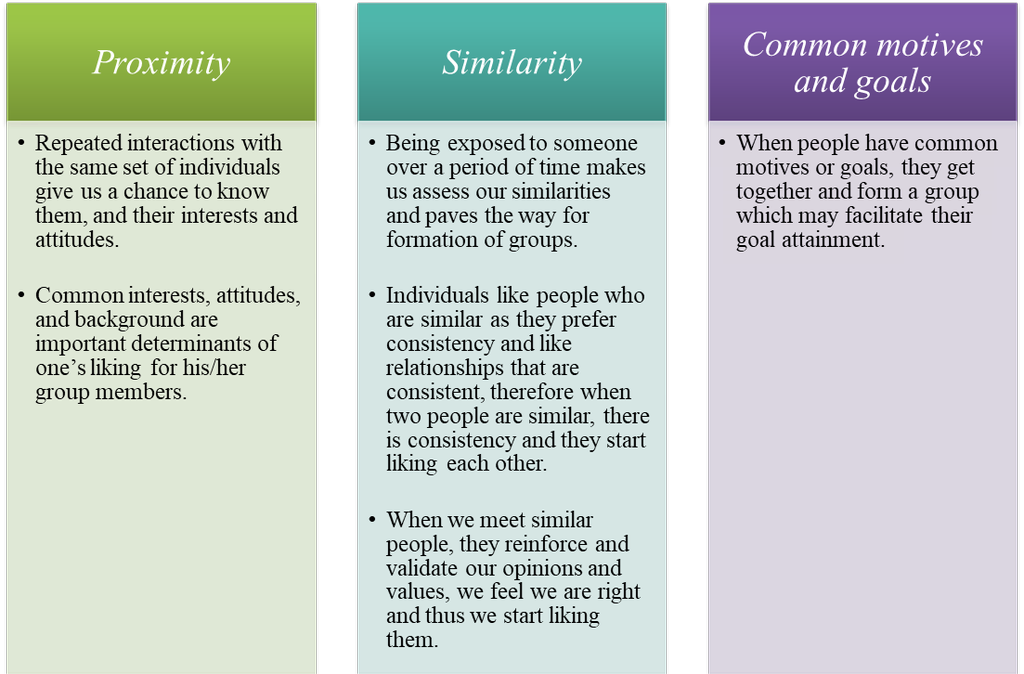
Stages of Group Formation
Tuckman suggested that groups pass through five developmental sequences:

Forming
- When group members first meet, there is a great deal of uncertainty about the group, the goal, and how it is to be achieved.
- People try to know each other and assess whether they will fit in.
- There is excitement as well as apprehensions.
Storming
- It is a stage of intragroup conflict; there is conflict among members about:
- how the target of the group is to be achieved
- who is to control the group and its resources
- who is to perform what task
- When this stage is complete, some sort of hierarchy of leadership in the group develops and a clear vision as to how to achieve the group goal.
Norming
- Group members by this time develop norms related to group behaviour. This leads to development of a positive group identity.
Performing
- The structure of the group has evolved and is accepted by group members, by now.
- The group moves towards achieving the group goal.
- For some groups, this may be the last stage of group development.
Adjourning
- In this stage, once the task is successfully completed, the group may be disbanded.
- However, it must be stated that all groups do not always proceed from one stage to the next in such a systematic manner.
- Sometimes several stages go on simultaneously, while in other instances groups may go back and forth through the various stages or they may just skip some of the stages.
Elements of Group Structure

- Roles
- They are socially defined expectations that individuals in a given situation are expected to fulfil.
- Roles refer to the typical behaviour that depicts a person in a given social context.
- An individual may have the role of a son or a daughter and with this role, there are certain role expectations, i.e. including the behaviour expected of someone in a particular role. For example, as a son or a daughter, one is expected to respect elders, listen to them, etc.
- Norms
- They are expected standards of behaviour and beliefs established, agreed upon, and enforced by group members.
- They may be considered as a group’s ‘unspoken rules’.
- Norms represent shared ways of viewing the world.
- Status
- It refers to the relative social position given to group members by others.
- This relative position or status may be either:
- ascribed (according to one’s seniority), or
- achieved (according to one’s expertise or hard work)
- By being members of the group, we enjoy the status associated with that group. All of us, therefore, strive to be members of such groups which are high in status or are viewed favourably by others.
- Even within a group, different members have different prestige and status. Although all amay be equally important for the team’s success.
- Cohesiveness
- It refers to togetherness, binding, or mutual attraction among group members.
- As the group becomes more cohesive, group members start to think, feel and act as a social unit, and less like isolated individuals.
- Members of a highly cohesive group have a greater desire to remain in the group in comparison to those who belong to low cohesive groups.
- Cohesiveness refers to the team spirit or ‘we feeling’ or a sense of belongingness to the group.
- It is difficult to leave a cohesive group or to gain membership of a group which is highly cohesive.
- Extreme cohesiveness however, may sometimes not be in a group’s interest leading to ‘groupthink’ i.e. a mode of thinking in which the desire to reach unanimous agreement over-rides the wish to adopt proper, rational, decision-making procedures (defined by Irving Janis).
Type of Groups
- Primary and Secondary Groups
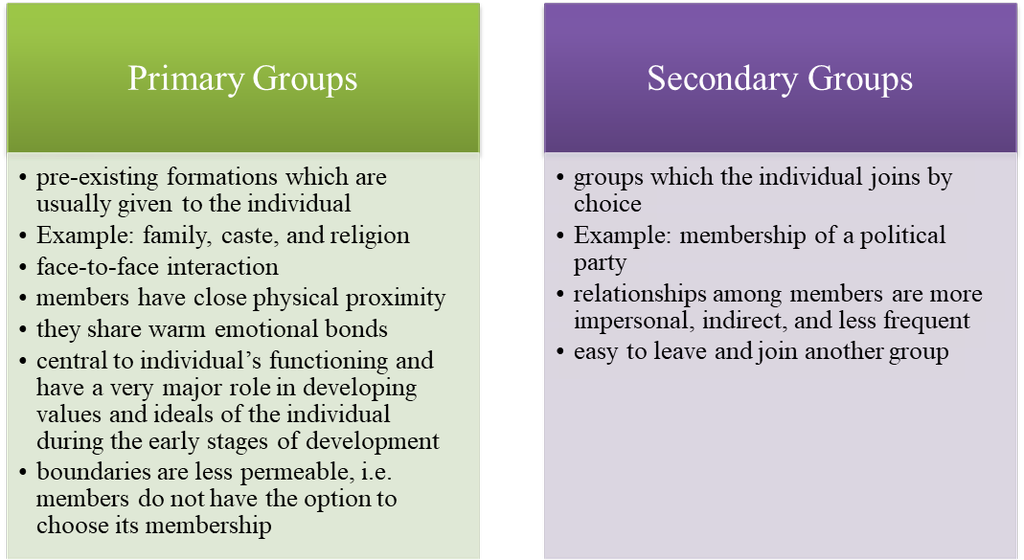
- Formal and Informal Groups
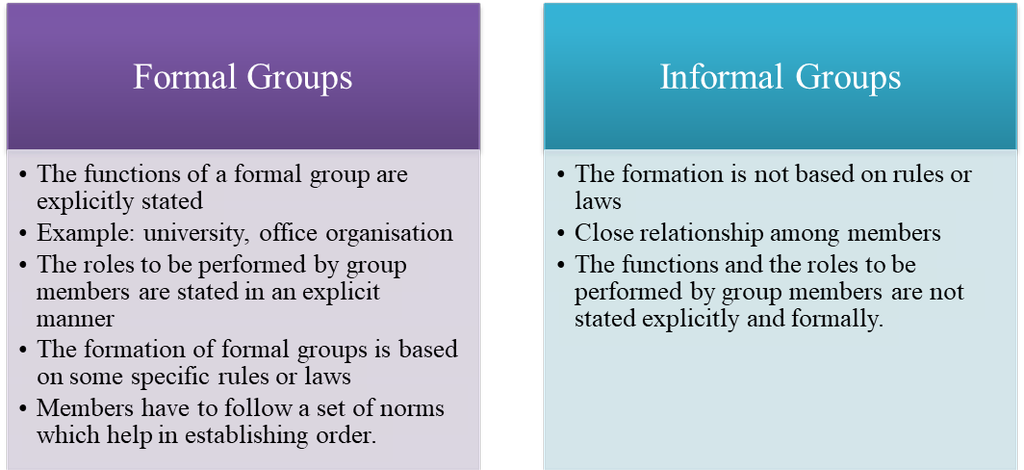
- Ingroup and Outgroup (Perceptions of ingroup and outgroup affect our social lives)
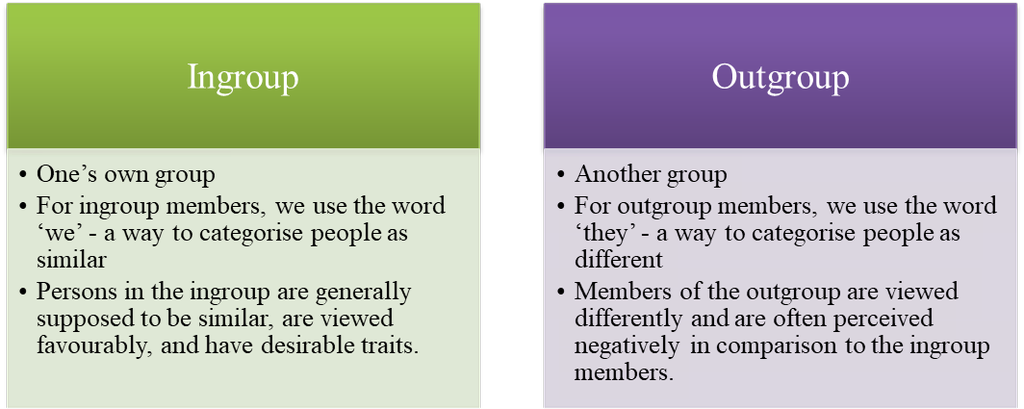
Influence of Group on Individual Behaviour
- Books Name
- Psychology Book Class-12
- Publication
- PathSet Publications
- Course
- CBSE Class 12
- Subject
- Psychology
Influence of Group on Individual Behaviour
Impact of the presence of others on one’s performance:
- Social Facilitation
- An individual performing an activity alone in the presence of others.
- Presence of others leads to arousal and can motivate individuals to enhance their performance if they are already good at solving something.
- This enhancement occurs when a person’s efforts are individually evaluated.
- Social Loafing
- An individual performing an activity along with the others as part of a larger group.
- Individuals work less hard in a group than they do when performing alone.
- Social loafing is a reduction in individual effort when working on a collective task, i.e. one in which outputs are pooled with those of other group members.
- Example: the game of tug-of-war as it is not possible for us to identify how much force each member of the team has been exerting. Such situations give opportunities to group members to relax and become a free rider.
- Each participant/member puts in less effort as the group size increases (experiment be Latane).
- Reasons for social loafing:
- Group members feel less responsible for the overall task being performed and therefore exert less effort.
- Motivation of members decreases because they realise that their contributions will not be evaluated on individual basis.
- The performance of the group is not to be compared with other groups. • There is an improper coordination (or no coordination) among members.
- Belonging to the same group is not important for members. It is only an aggregate of individuals.
- Social loafing may be reduced by:
- Making the efforts of each person identifiable.
- Increasing the pressure to work hard (making group members committed to successful task performance).
- Increasing the apparent importance or value of a task.
- Making people feel that their individual contribution is important.
- Strengthening group cohesiveness which increases the motivation for successful group outcome.
- Group Polarisation
- Groups are more likely to take extreme decisions than individuals alone.
- Whatever the initial position in the group, this position becomes much stronger as a result of discussions in the group. This strengthening of the group’s initial position as a result of group interaction and discussion is referred to as group polarisation.
- A phenomena wherein the decisions and opinions of people in a group setting become more extreme than their actual, privately held beliefs.
- This may sometimes have dangerous repercussions as groups may take extreme positions, i.e. from very weak to very strong decisions.
- Example: After a discussion about racism, members of the group who are racist will defend their attitudes far more strongly than they would have beforehand.
- Reasons for group polarisation:
- In the company of like-minded people, you are likely to hear newer arguments favouring your viewpoints. This will make you more favourable towards your own point of view.
- When you find others also favouring your opinion, you feel that this view is validated by the public. This is called the bandwagon effect.
- When you find people having similar views, you are likely to perceive them as ingroup. You start identifying with the group, begin showing conformity, and as a consequence your views become strengthened.
Conformity, Compliance, and Obedience
- Books Name
- Psychology Book Class-12
- Publication
- PathSet Publications
- Course
- CBSE Class 12
- Subject
- Psychology
Conformity, Compliance and Obedience (group influence processes)
- Social influence refers to those processes whereby our attitudes and behaviours are influenced by the real or imagined presence of other people.
- Social influence is a part of our life.
- In some situations, social influence on us is very strong as a result of which we tend to do things which we otherwise would have not done.
- On other occasions, we are able to defy influence of others and may even influence them to adopt our own viewpoint.
- Kelman distinguished three forms of social influence:
- Compliance
- In compliance, there are external conditions that force the individual to accept the influence of the significant other.
- Compliance also refers to behaving in a particular way in response to a request made by someone.
- Can also be called ‘external/public conformity’.
- Compliance could take place even without a norm.
- We sometimes show compliance not because of a group norm or even because we personally believe in the same, but because we see no harm or problem in it. And one finds it easier to say ‘yes’ rather than ‘no’ to a harmless request.
- Identification
- It refers to influence process based on agreement-seeking or identity-seeking.
- Internalisation
- It is a process based on information-seeking.
Conformity
- A type of social influence in which the individuals change their attitudes or behaviour in order to adhere to existing social norms.
- It also means behaving according to the group norms i.e. the expectations of other group members.
- People who do not conform are called ‘deviants’ or ‘non-conformists’ and get noticed more than those who do conform.
- Conformity is the most indirect form of social influence as you are conforming because you do not want to deviate from the norm.
- The tendency to follow a norm is natural and spontaneous because:
- Norms represent a set of unwritten and informal ‘rules’ of behaviour that provide information to members of a group about what is expected of them in specific situations. This makes the whole situation clearer, and allows both the individual and the group to function more smoothly.
- In general, people feel uncomfortable if they are considered ‘different’ from others. Behaving in a way that differs from the expected form of behaviour may lead to disapproval or dislike by others, which is a form of social punishment. This is something that most people fear, often in an imagined way.
- The norm is seen as reflecting the views and beliefs of the majority. Most people believe that the majority is more likely to be right rather than wrong. Thus, people conform to the norm because they believe that the majority must be right.
Determinants of Conformity:
- Size of the group
- Conformity is greater when the group is small than when the group is large.
Small group -> Greater conformity
Large group ->Lesser conformity
- This is because it is easier for a deviant member (one who does not conform) to be noticed in a small group.
- However, in a large group, if there is strong agreement among most of the members, this makes the majority stronger, and therefore, the norm is also stronger. In such a case, the minority member(s) would be more likely to conform because the group pressure would be stronger.
- Size of the minority
- When the dissenting or deviating minority size increases, the likelihood of conformity decreases.
- In fact, it may increase the number of dissenters or non-conformists in the group.
Increase in size of minority -> Decrease in conformity
Decrease in size of minority -> Increase in conformity
- Nature of the task
- In the task which requires an answer that could be verified and could be correct or incorrect, there would be more conformity than in the task which involves giving an option about some topic where answers can vary widely without any answer being correct or incorrect.
- Public or private expression of behaviour
- When the group members are asked to give their answers publicly, i.e. all members know who has given which response, then the conformity is more.
- However, there can be other situations (for example, voting by secret ballot) in which the behaviour of members is private (not known to others), then the conformity would be less.
- Personality
- Some individuals have a conforming personality.
- Such persons have a tendency to change their behaviour according to what others say or do in most situations.
- By contrast, there are individuals who are independent, and do not look for a norm in order to decide how to behave in a specific situation.
- Highly intelligent people, those who are confident of themselves, those who are strongly committed and have a high selfesteem are less likely to conform.
Conformity takes place because of:
- Informational influence
- Influence that results from accepting evidence rather than reality
- This kind of rational conformity can be thought of as learning about the world from the actions of others.
- For instance, we learn by observing people, who are the best source of information about many social conventions, or new group members learn about the group’s customs by observing the actions of other group members.
- Normative influence
- Influence based on a person’s desire to be accepted or admired by others.
- In such cases, people conform because deviation from group may lead to rejection or at the least, non-acceptance of some form of punishment.
It is generally observed that the group majority determines the final decision, but in certain conditions, a minority may be more influential. This occurs when the minority takes a firm and uncompromising stand, thereby creating a doubt on the correctness of the majority’s viewpoint.
Compliance
- It refers simply to behaving in response to a request from another person or group even in the absence of a norm.
- It is less direct than obedience because someone has requested and thus we comply (here, the probability of refusal is there).
- In many situations, people comply because:
- it is an easy way out of the situation
- it is more polite and the other party is pleased
- The following techniques have been found to work when someone wants another person to comply:

Obedience
- When compliance is shown to an instruction or order from a person in authority, that behaviour is called obedience.
- Obedience is the most direct and explicit form of social influence.
- We show obedience because if we disobey, some punishment might follow or we believe that persons in authority must be obeyed.
- People in authority have effective means for enforcing their orders.
- Milgram’s study suggests that even ordinary people are willing to harm an innocent person if ordered by someone in authority.
- Reasons for Obedience even when people know that their behaviour is harming others:
- People obey because they feel that they are not responsible for their own actions, they are simply carrying out orders from the authority.
- Authority generally possesses symbols of status (e.g., uniform, title) which people find difficult to resist.
- Authority gradually increases commands from lesser to greater levels and initial obedience binds the followers for commitment. Once you obey small orders, slowly there is an escalation of commitment for the person who is in authority and one starts obeying bigger orders.
- Many times, events are moving at such a fast speed, for example in a riot situation, that one has no time to think, just obey orders from above.
Cooperation & Competition
- Books Name
- Psychology Book Class-12
- Publication
- PathSet Publications
- Course
- CBSE Class 12
- Subject
- Psychology
Cooperation & Competition
- Behaviours in most social situations are characterised by:
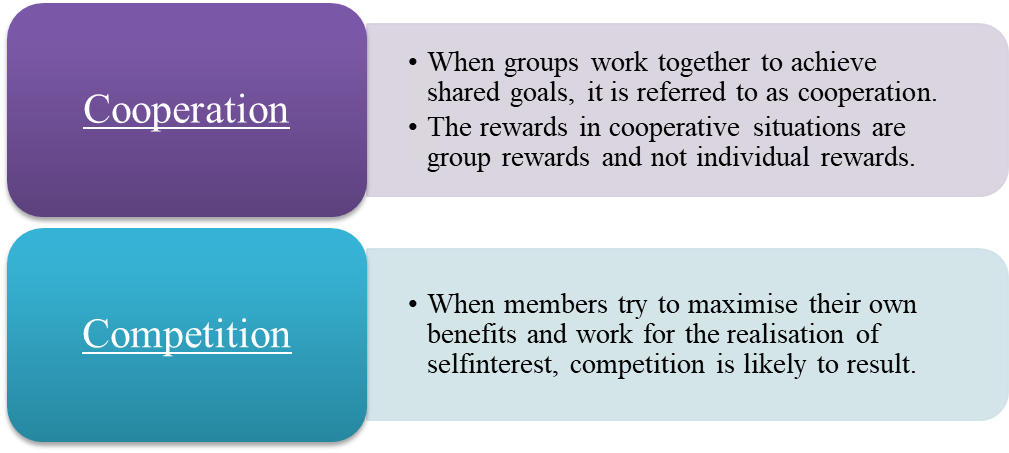
- Social groups may have both competitive as well as cooperative goals.
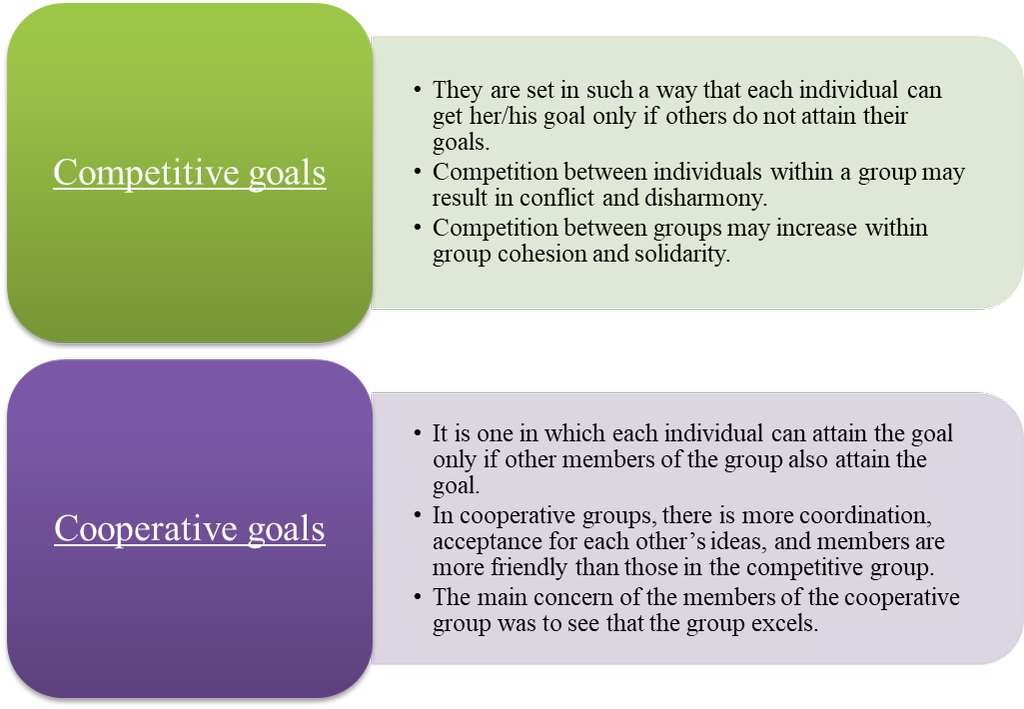
- Determinants of Cooperation and Competition
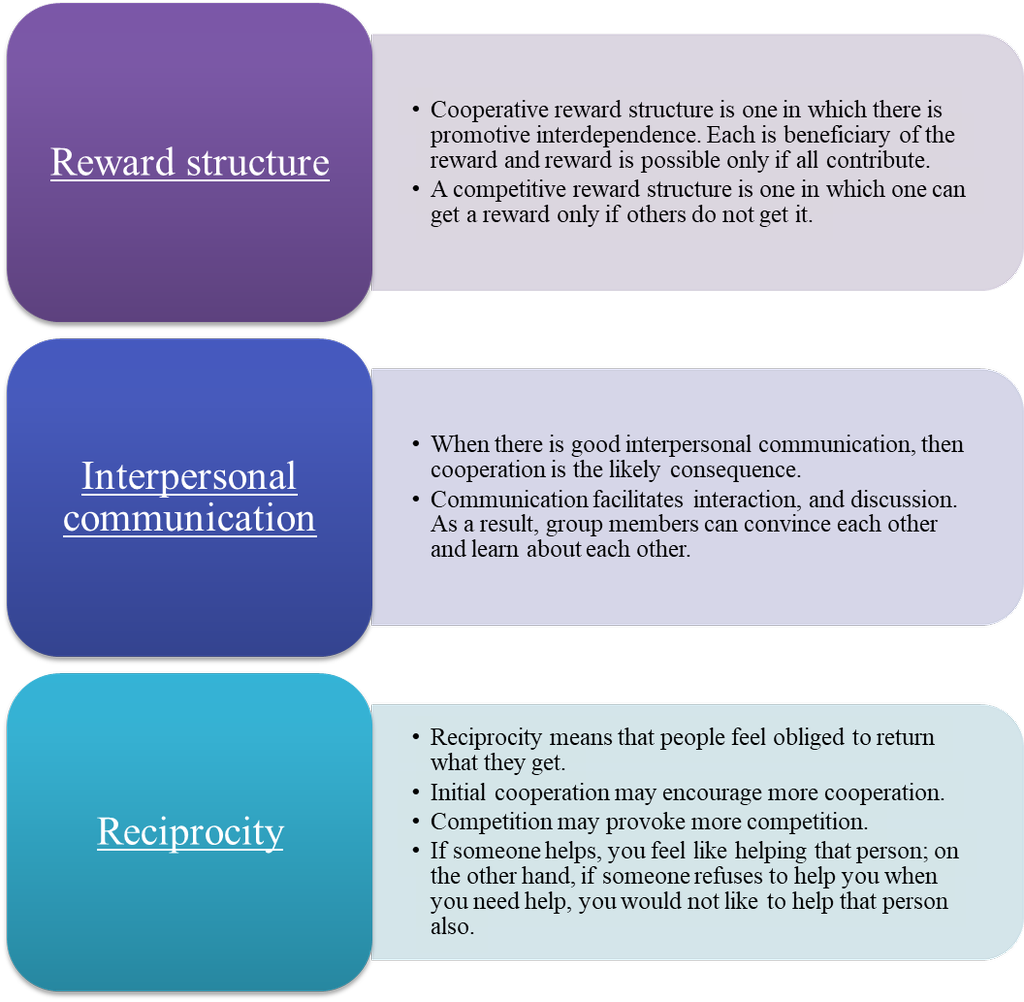
- Superordinate goals
- A goal to which personal goals were subordinated.
- Superordinate goals could be achieved only through cooperation between the groups.
Social Identity
- Books Name
- Psychology Book Class-12
- Publication
- PathSet Publications
- Course
- CBSE Class 12
- Subject
- Psychology
Social Identity
- It is that aspect of our self-concept which is based on our group membership.
- Social identity places us, i.e. tells us what and where we are in the larger social context, and thus helps us to locate ourselves in society.
- Social identity provides members with a shared set of values, beliefs and goals about themselves and about their social world, which helps to coordinate and regulate their attitudes and behaviour.
- When we develop a strong identity with our own group, the categorisation as ingroup and outgroup becomes salient. The group with which we identify ourselves becomes the ingroup and others become the outgroup.
The negative aspect of this own group and outgroup categorisation is that we start showing favouritism towards our ingroup by rating it more favourably in comparison to the outgroup, and begin devaluating the outgroup. This devaluation of the outgroup is the basis of a number of intergroup conflicts
Intergroup Conflict : Nature and Causes
- Books Name
- Psychology Book Class-12
- Publication
- PathSet Publications
- Course
- CBSE Class 12
- Subject
- Psychology
Intergroup Conflict: Nature and Causes
- Conflict is a process in which either an individual or a group perceives that others (individual or group) have opposing interests, and both try to contradict each other.
- There is this intense feeling of ‘we’ and ‘other’/‘they’.
- There is also a belief by both parties that the other will protect only its own interests; their (the other side’s) interests will, therefore, not be protected.
- There is not only opposition of each other, but they also try to exert power on each other.
- Groups have been found to be more aggressive than individuals.
- This often leads to escalation of conflict.
- All conflicts are costly as there is a human price for them.
- Reasons for group conflicts:
- Lack of communication and faulty communication by both parties.
This kind of communication leads to suspicion, i.e. there is a lack of trust. Hence, conflict results.
- Relative deprivation
When members of a group compare themselves with members of another group, and perceive that they do not have what they desire to have, which the other group has.
They feel that they are not doing well in comparison to other groups. This may lead to feelings of deprivation and discontentment, which may trigger off conflict.
- One party’s belief that it is better than the other, and what it is saying should be done.
When this does not happen, both parties start accusing each other.
One may often witness a tendency to magnify even smaller differences, thereby conflict gets escalated because every member wants to respect the norms of her/his group.
- A feeling that the other group does not respect the norms of my group, and actually violates those norms because of a malevolent intent.
- Desire for retaliation for some harm done in the past
- Biased perceptions are at the root of most conflicts. As already mentioned earlier, feelings of ‘they’ and ‘we’ lead to biased perceptions.
- When acting in groups, people are more competitive as well as more aggressive than when they are on their own.
Groups compete over scarce resources, both material resources, e.g. territory, and money as well as social resources, e.g. respect and esteem.
- Perceived Inequity
Equity refers to distribution of rewards in proportion to an individual’s contributions.
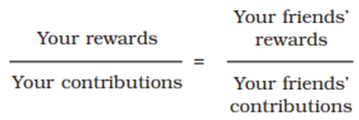
But if you contribute more and get less, one may feel irritated and exploited.
- Conflicts between groups give impetus to a series of social and cognitive processes.
These processes harden the stand of each side leading to ingroup polarisation.
This may result in coalition formation of like-minded parties, thereby increasing the apprehensions of both parties resulting in misperceptions, and biased interpretations and attributions.
The result is increased conflict.
- Gardner Murphy wrote a book entitled ‘In the Minds of Men’.
According to it, most conflicts begin in the minds of men and then go to the field.
Explanations of such conflicts can be at:
- Structural level
Structural conditions include:
- high rates of poverty
- economic and social stratification
- inequality
- limited political and social opportunity
- Group Level
Following group level factors lead to escalation of conflict:
- social identit
- realistic conflict between groups over resources
- unequal power relations between groups
- Individual Levels
Following are the important determinants of conflict:
- beliefs
- biased attitudes
- personality characteristics
At the individual level, there is a progression along a continuum of violence.
Small acts that initially may have no significance, like calling the other group a name, may lead to psychological changes that make further destructive actions possible.
Deutsch identified the following consequences of intergroup conflict:
- Communication between the groups becomes poor. The groups do not trust each other, thereby leading to a breakdown in communication and this generates suspicion for each other.
- Groups start magnifying their differences and start perceiving their behaviour as fair and the other’s behaviour as unfair.
- Each side tries to increase its own power and legitimacy. As a consequence, the conflict gets escalated shifting from few specific issues to much larger issues.
- Once conflict starts, several other factors lead to escalation of conflict which are:
- Hardening of ingroup opinion
- Explicit threats directed at the outgroup
- Each group retaliating more and more
- Other parties also choosing to take sides
Conflict Resolution Strategies
- Books Name
- Psychology Book Class-12
- Publication
- PathSet Publications
- Course
- CBSE Class 12
- Subject
- Psychology
Conflict Resolution Strategies
- Conflicts can be reduced if we know about their causes.
- The processes that increase conflict can be turned around to reduce it also.
Conflict Resolution Strategies:
Introduction of superordinate goals
By introducing superordinate goals, intergroup conflict can be reduced.
A superordinate goal is mutually beneficial to both parties, hence both groups work cooperatively.
Altering perceptions
Conflicts can also be reduced by altering perceptions and reactions through:
- Persuasion
- Educational and media appeals
- Portrayal of groups differently in society
Promoting empathy for others should be taught to everyone right from the beginning.
Increasing intergroup contacts
Conflict can also be reduced by increasing contacts between the groups which can be done by involving groups in conflict on neutral grounds through community projects and events.
The idea is to bring them together so that they become more appreciative of each other’s stand.
However, for contacts to be successful, they need to be maintained, which means that they should be supported over a period of time.
Redrawing group boundaries
This can be done by creating conditions where groups boundaries are redefined and groups come to perceive themselves as belonging to a common group.
Negotiations
Conflict can also be resolved through negotiations and third party interventions. Warring groups can resolve conflict by trying to find mutually acceptable solutions. This requires understanding and trust.
Negotiation refers to reciprocal communications so as to reach an agreement in situations in which there is a conflict.
Sometimes it is difficult to dissipate conflict through negotiations; at that time mediation and arbitration by a third party is needed.
Mediators help both parties to focus their discussions on the relevant issues and reach a voluntary agreement.
In arbitration, the third party has the authority to give a decision after hearing both parties.
Structural solutions
Conflict can be reduced by redistributing the societal resources according to principles based on justice.
Some of the principles of justice are :
- equality (allocating equally to every one)
- need (allocating on the basis of needs)
- equity (allocating on the basis of contributions of members).
Respect for other group’s norms
In a pluralist society like India, it is necessary to respect and be sensitive to the strong norms of various social and ethnic groups.
Aa number of communal riots between different groups have taken place because of such insensitivity.

 PathSet Publications
PathSet Publications
